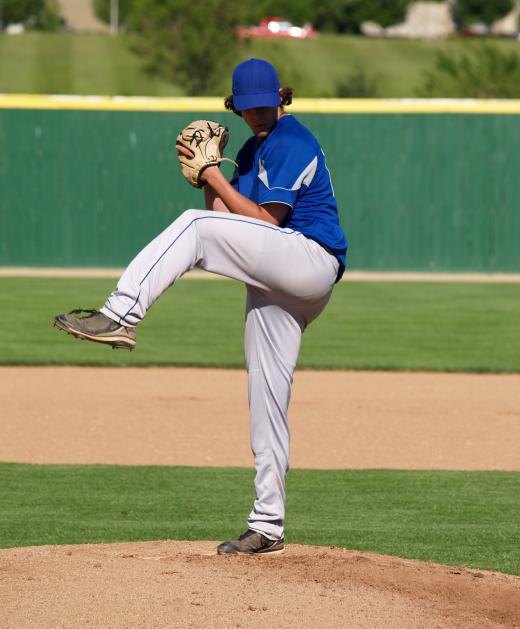At Sports&Hobbies, we're committed to delivering accurate, trustworthy information. Our expert-authored content is rigorously fact-checked and sourced from credible authorities. Discover how we uphold the highest standards in providing you with reliable knowledge.
What is the Most Common Way to Balk?
In baseball, a pitcher can commit a balk when he makes an illegal motion before or during his pitch delivery. There are many ways a pitcher can commit a balk, and any time he does so, any runners on base advance to the next base unchallenged. If a runner is standing on third base when a pitcher commits a balk, that runner is allowed to cross home plate to score, thereby awarding the runner's team a point, known as a run. Many of the most common ways to balk include arm or foot motions that the pitcher makes in any other direction than toward home plate.
Perhaps the most common way to balk occurs when a pitcher does not come to the set position before delivering a pitch. In other words, a pitcher must come to a complete standstill before delivering a pitch--his hands and feet must be completely still before throwing. Determining whether a pitcher has come to a complete stop is somewhat of a subjective decision made by an umpire, and some umpires are more attentive to such motions than others.

Another way a pitcher can commit a balk occurs if a pitcher makes a motion to first, second, or third base before delivering a pitch to home plate. Again, such a determination is subjective and relies on the attentiveness of one or more umpires. For example, if a pitcher is pitching from the wind-up position--the position most commonly used when there are runners on base--and makes a step or lean toward first base before delivering his pitch, the umpire will award second base to the runner. The pitcher's motion toward first may come in the form of a lean toward the base, a shoulder motion toward first, or a hand motion toward first base. A pitcher, for example, could not pretend to throw the ball to first base and then deliver the pitch to home plate.

A pitcher can, however, look at first base as he delivers the pitch. This is not considered a balk and is completely acceptable. However, if there is a runner on second base and the pitcher turns his shoulders toward second base before delivering the pitch, the umpire will call this a balk and award third base to the runner. A pitcher can look at second base for as long as he pleases before delivering a pitch, as long as he does not turn his shoulders or the rest of his body toward second base. Further, if a pitcher chooses to attempt to pick off the runner at second base, he must first step off the pitcher's rubber before he turns to throw to second. Otherwise, his motion will be considered a balk.
AS FEATURED ON:
AS FEATURED ON:














Discussion Comments
Pitchers from stretch touches ground with lead foot after starting delivery then continues to plate. Is this a balk?
Can a pitcher move his fingers after he has set?
For #6: A lot of MLB pitchers do that.
Since a balk refers to trying to trick a base runner, there can be no balk with no base runner.
Normally, when in the windup position, there are no base runners. Without base runners, the pitcher can do things that he cannot do with runners on base: 1) he can pitch from the stretch and never pause or become set (as long as it is not a quick pitch); 2) pitch from the windup position and pause at the top of his windup.
With runners on base, it would be dumb to start in the windup position and pause because you would be giving up a base to a base runner.
For #5: A balk, by analysis of the definition, is an act to get an edge on a runner. The catcher has a defined space from which to work while the pitcher is on the mound and toeing the rubber. Should the catcher step outside of that defined space before the pitcher releases the ball in a pitch to home, that is a catcher's balk.
The reason the catcher would do that by accident is to receive a pitch during an intentional walk. The reason to do it on purpose is to get into a better position to throw out a base stealer. Whether by accident or by design, it is still a balk.
What if a pitcher is in the wind up position and stops at the windup, waits a second and then delivers the ball to home? Is that a balk?
zcwh: Can a catcher commit a balk? If so how?
stretch with runners on, wind-up when bases empty.
john w.
You're correct. That is a typo in the article.
The most appropriate delivery option when there are runners on base is from the stretch, but the pitcher must still come to a complete stop before delivering the pitch.
Typically, if the bases are loaded, the pitcher can choose to throw from the wind-up or from the stretch.
I was reading on this site the most common ways to commit a balk, and it says that the most common delivery option for the pitcher is the wind up, when there are runners on base.
I thought the stretch was a more appropriate delivery option, given the fact it takes less time to deliver the ball to the plate.
Am I confused about this? It seems if there was just a runner on third, the wind up would be OK, but first and/or second the stretch might be better served. Please clarify this for me.
Post your comments